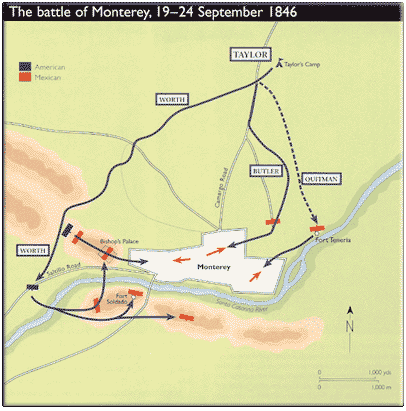Battle of Monterrey
The fortified city of Monterrey, capital of the northeastern Mexican state of Nuevo Leon, stood in the path of Zachary Taylor's advance through northeastern Mexico in the fall of 1846. Its citizens witnessed a valiant defense mounted by 10,000 Mexican soldiers.

On September 21, a contingent of Texas Rangers successfully stormed Federation Hill on the town's outskirts. Captured cannon were used to great effect on the retreating Mexican defenders. Independence Hill was taken the following day.
Fighting within the city, which amounted to a door-to-door struggle, was especially fierce. When the battle appeared to turn against him, the Mexican commander, General Pedro de Ampudia, called for a truce. His request was granted and Taylor agreed to a two-month cessation in hostilities. Mexican forces took advantage of the temporary peace to quickly withdraw from the area.
The press, Congress and
President Polk were highly critical of Taylor's decision to grant the armistice. Under mounting pressure, Taylor was forced to contact General
Santa Anna and rescind the agreement. Taylor resumed action and successfully seized neighboring Saltillo on November 16.
Polk was convinced by Taylor's lethargy that a change was needed. He accepted a
plan presented by
Winfield Scott to prepare an invasion force and move from the Gulf of Mexico directly against the capital, Mexico City. A portion of the soldiers under Taylor was reassigned to the new campaign. Polk was genuinely concerned about Taylor's leisurely conduct of the war, but he also was wary of the general as a possible
political rival; that concern would prove to have a firm foundation.
United States losses during the Battle of Monterrey amounted to 120 killed and 368 wounded. On the Mexican side, 338 men and 29 of their officers died.
The name "Monterrey" is derived from the same source as "Monterey" in California, and means loosely "king's hill." Today, Monterrey is one of Mexico's leading industrial cities.
